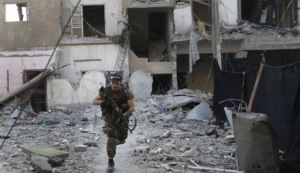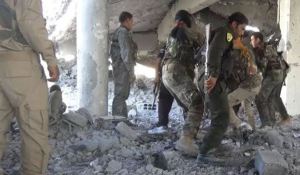nsnbc : After heavy fighting Thursday, the U.S.-backed Syrian Democratic Forces now control almost half of the self-proclaimed Islamic State’s capital Raqqa. However, the forces meet increasingly stiff resistance the closer to ISIS’s main defensive positions while the use of air power becomes increasingly difficult, if not impossible, due to the presence of non-combatant civilians. Meanwhile, the Syrian Arab Army and allied forces are also making stead progress against ISIS and al-Qaeda-linked groups.
A Syrian Democratic Forces spokeswoman said progress is slowing down due to stiff resistance and large amounts of explosives planted by ISIS fighters. The attack on Raqqa by the U.S.-backed, predominantly Syrian – Kurdish Syrian Democratic Forces (SDF) was launched on June 6 after months of preparations and battles for control over surrounding areas. U.S. forces involvement includes air support, artillery support, as well as frontline support by special operations forces who are also present among SDF fighters inside Raqqa city.
The fall of Raqqa city would, after the recent fall of Mosul, constitute a significant loss for the Islamic State. ISIS may, after the fall of Raqqa, still constitute a substantial and global threat. However, it would, at least for some time, have lost the capacity to control a state-like territory. U.S. Army Col. Ryan Dillon, spokesman for the U.S.-led coalition fighting the Islamic State, said 45 percent of Raqqa was now under the control of the SDF. He stated that the SDF cleared about 9 square miles of terrain this past week fighting against “stiff, sporadic resistance” from IS militants entrenched in Raqqa.
Commanders on the western Raqqa front line said there were about 800 meters left before SDF forces moving from east and west would connect, tightening the noose on ISIS. The battlefield Thursday was busy with hundreds of SDF fighters taking cover inside destroyed buildings less than 500 meters from ISIS combatants. SDF troops lobbed dozens of mortar shells at the militants, who sent out armed drones above the SDF forces.
Meanwhile, on Thursday, Ursula Mueller, a senior U.N. humanitarian official, told the UN Security Council, via a video link from Jordan, that an estimated 20,000 to 50,000 people remained in Raqqa. Mueller stressed that the city was encircled and that there was no way for those civilians to get out. About 200,000 people have fled Raqqa city since April 1, she said, including 30,000 displaced just in July.
As the extremists become more surrounded, they have increased their suicide attacks on fighters of the SDF, said Nisren Abdullah, a Kurdish spokeswoman to reporters. She also stressed that progress had slowed down because ISIS had left huge amount of explosives behind. Abdullah, a member of the Syrian Kurdish Women’s Protection Units (YPJ) said:
“Raqqa has become a booby-trapped city and this shows their weakness. … They are also using civilians as human shields and this is slowing the push as well.”
She said that the SDF which includes the YPJ, now controls 45 percent of Raqqa. She added that since the offensive began, SDF fighters have fully captured eight neighborhoods. Mustafa Bali, the head of the SDF media center, also said that the SDF are now controlling about half of Raqqa city. He added that the most important areas liberated in the past four days were the Nazlet Shehadeh and Panorama Square neighborhoods, on the southwestern part of the city.
However, he also said there are ISIS counter-attacks, sleeper cells, and he stressed that ISIS is also using tunnel warfare to launch attacks. SDF commander Jihad Khabat told about the eastern front sector that SDF forces have breached ISIS’s defenses on the edge of the old city about one month ago and that SDF fighters have now reached the old citadel. He added:
“As we move forward we find a tunnel every 100 meters… The enemy is besieged, in distress, and hides in deep and long tunnels under the city, from where they can hist Syrian fighters in daily counter attacks.”
Meanwhile, the Syrian Arab Army and allied forces are also making progress. The Syrian government controlled Syrian Central Military Media (SCMM) reported that fighting edged closer to the ISIS stronghold of Sukhna, the last major ISIS-controlled town in Homs province. Syrian Arab Army (SAA) and allied troops reportedly killed and wounded an unspecified number of ISIS fighters near a mountain that overlooks the area. Troops are now, reportedly, about 5 kilometers – three miles – from the town that has been held by ISIS since the summer of 2015.
Near the Syrian – Lebanese border a ceasefire agreement was reached between Lebanese Hezbollah and groups of al-Qaeda-linked militants. The ceasefire came into effect Thursday morning as negotiations were underway that would eventually lead to an agreement about the evacuation of the al-Qaeda affiliated fighters to the northwestern, “rebel-held” Idlib province. The truce came after a six-day-long offensive by both Hezbollah and Syrian troops. Senior Lebanese security official, Gen. Abbas Ibrahim, who is leading the negotiations, told reporters in Beirut that the details of the deal will remain secret. He added that the fighters and their families who decide to leave for Idlib will do it under the supervision of Lebanese authorities.
CH/L – nsnbc 28.07.2017
Source Article from https://nsnbc.me/2017/07/28/u-s-backed-syrian-democratic-forces-control-almost-half-of-raqqa-city/
Related posts:
Views: 0
 RSS Feed
RSS Feed















 July 28th, 2017
July 28th, 2017  Awake Goy
Awake Goy 












 Posted in
Posted in  Tags:
Tags: 
















